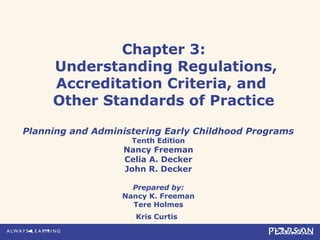
Chapter 3 Slides
- 1. Chapter 3: Understanding Regulations, Accreditation Criteria, and Other Standards of Practice Planning and Administering Early Childhood Programs Tenth Edition Nancy Freeman Celia A. Decker John R. Decker Prepared by: Nancy K. Freeman Tere Holmes Kris Curtis
- 2. 3-2 Freeman/Decker/Decker, Planning and Administering Early Childhood Programs, 10e © 2012, 2008, 2005, 2001, 1995 by Pearson Education, Inc. All Rights Reserved Definitions •Regulation: A binding rule created outside the program. •Standard: A statement of expectations for program characteristics and performance.
- 3. 3-3 Freeman/Decker/Decker, Planning and Administering Early Childhood Programs, 10e © 2012, 2008, 2005, 2001, 1995 by Pearson Education, Inc. All Rights Reserved Types of Regulations • Zoning regulations govern land use. • Building codes address issues such as wiring, plumbing, building materials. • Fire and sanitation regulations set health and safety standards. • Child care licensing regulations establish minimal levels of health & safety
- 4. 3-4 Freeman/Decker/Decker, Planning and Administering Early Childhood Programs, 10e © 2012, 2008, 2005, 2001, 1995 by Pearson Education, Inc. All Rights Reserved States’ child care center licensing codes typically address: • The process of obtaining a license • The program’s organization and administration • Staffing patterns including required adult:child ratios and group size
- 5. 3-5 Freeman/Decker/Decker, Planning and Administering Early Childhood Programs, 10e © 2012, 2008, 2005, 2001, 1995 by Pearson Education, Inc. All Rights Reserved States’ child care center licensing codes typically address: (continued) • Minimal standards for facilities, supplies, & equipment and provisions for transporting children • Procedures to safeguard children’s health and safety • Types of activities that are to be part of children’s daily routines including required activity centers
- 6. 3-6 Freeman/Decker/Decker, Planning and Administering Early Childhood Programs, 10e © 2012, 2008, 2005, 2001, 1995 by Pearson Education, Inc. All Rights Reserved States’ child care center licensing codes typically address: (continued) • Allowable forms of discipline • How programs are to communicate with and involve families • Nutritional content of meals & snacks, time intervals between meals & snacks, and regulations about posting menus.
- 7. 3-7 Freeman/Decker/Decker, Planning and Administering Early Childhood Programs, 10e © 2012, 2008, 2005, 2001, 1995 by Pearson Education, Inc. All Rights Reserved Regulations for child care homes • Compliance is usually voluntary • Regulations are typically very similar to those for centers • Home-based programs are often registered instead of licensed ○ Registration addresses health & safety and requires criminal background checks
- 8. 3-8 Freeman/Decker/Decker, Planning and Administering Early Childhood Programs, 10e © 2012, 2008, 2005, 2001, 1995 by Pearson Education, Inc. All Rights Reserved Administrators’ Qualifications Licensure is most likely to require: • Child Development Associate (CDA) – the most frequently required specialized training • Director’s credential from a community or technical college - required by just 4 states
- 9. 3-9 Freeman/Decker/Decker, Planning and Administering Early Childhood Programs, 10e © 2012, 2008, 2005, 2001, 1995 by Pearson Education, Inc. All Rights Reserved Accreditation • A voluntary system of program evaluation • Requires higher-than-minimal quality • Requires substantial (not full) compliance • Nationally developed, validated, and enforced • NAEYC Program Accreditation is considered the “gold standard”
- 10. 3- Freeman/Decker/Decker, Planning and Administering Early Childhood Programs, 10e © 2012, 2008, 2005, 2001, 1995 by Pearson Education, Inc. All Rights Reserved Quality Rating Improvement Systems (QRIS)/ Quality Rating Systems (QRS) • All states have QRIS/QRS in place or in development (most are voluntary) • Designed to help parents become more informed consumers • Designed to bridge the gap between minimal standards (licensing) and accreditation
- 11. 3- Freeman/Decker/Decker, Planning and Administering Early Childhood Programs, 10e © 2012, 2008, 2005, 2001, 1995 by Pearson Education, Inc. All Rights Reserved Legal existence of private programs Proprietorship • Owned by one person • Owner faces personal liability for all activities • No separate entity, tax owed by owners Partnership • 2 or more owners • Can own property as a separate legal entity • Owners face personal liability for business wrongs • No separate entity, tax owed by owners
- 12. 3- Freeman/Decker/Decker, Planning and Administering Early Childhood Programs, 10e © 2012, 2008, 2005, 2001, 1995 by Pearson Education, Inc. All Rights Reserved Types of private ownership (cont.) Limited liability company (LLC) • A separate legal entity • Established by filing with the state • Can be taxed like a partnership or corporation – owner’s choice • Limited personal liability for wrongdoings of employees Corporation • State law governs incorporation and operations • A separate legal entity • Operated by a board of directors • Can be Subchapter “S” or “C”; “S” corporations have limited corporate taxes
- 13. 3- Freeman/Decker/Decker, Planning and Administering Early Childhood Programs, 10e © 2012, 2008, 2005, 2001, 1995 by Pearson Education, Inc. All Rights Reserved Fiscal regulations •Violations can result in civil and/or criminal penalties. To avoid penalties: –Honor all contracts –Follow IRS regulations ○ Obtain Federal Employer Identification Number (FEIN) ○ File required tax returns ○ Withhold appropriate taxes from employees
- 14. 3- Freeman/Decker/Decker, Planning and Administering Early Childhood Programs, 10e © 2012, 2008, 2005, 2001, 1995 by Pearson Education, Inc. All Rights Reserved Laws that protect the staff and the program • Civil Rights Act (1964) & Equal Opportunity Act (1972) • American with Disabilities Act P.L. 101-336 (1990) • Fair Labor Standards Act (1938) • Family and Medical Leave Act (1993) It is important to stay abreast of current developments.